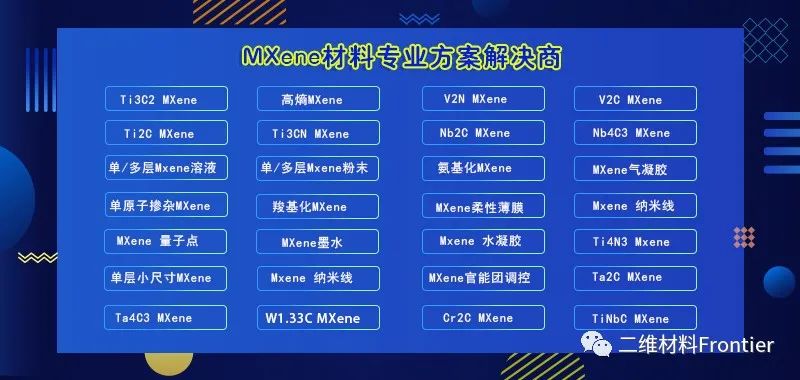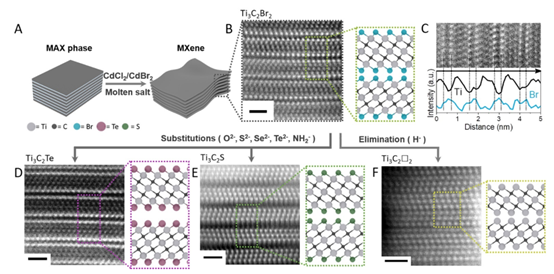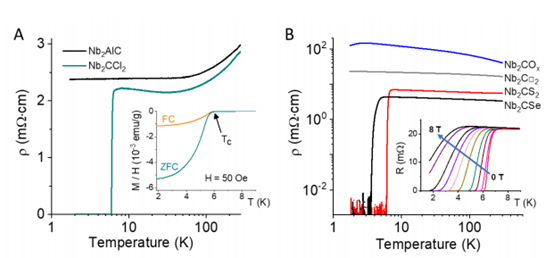
hotline:
17715390137
Tel/Wechat:
18101240246 (Technology)
0512-68565571
Email:mxenes@163.com (Sales Engineer)bkxc.bonnie@gmail.com
Scan the code to follow or search the official account on WeChat:
2D Materials Fronrier After paying attention,
click on the lower right corner to contact us,
Enter enterprise WeChat.
Professional Services Online

已传文件:photo/1631586161.png



Two-dimensional (2D) transition metal carbides and nitrides (MXenes) have been extensively studied in applications such as supercapacitors, batteries, electromagnetic shielding, composites, and catalysts. MXenes are usually obtained by etching from their corresponding MAX phase materials, such as aqueous HF solutions, which make the obtained MXenes have some functional groups, such as -F, -O, and -OH. These functional groups can be chemically modified, in contrast to other 2D materials such as graphene and transition metal chalcogenides. Recent theoretical calculations have shown that the selective functional groups of MXenes can lead to some outstanding properties such as non-closed/closed band gaps, room temperature electron mobility (104 cm2/Vs), widely controllable functionalities, semimetallicity, and 2D iron magnetic. The MXene covalently functionalized interface is believed to inspire new directions for the rational design of 2D functional materials.

Recently, Professor Dmitri V. Talapin of Argonne National Laboratory and University of Chicago published a research paper titled: Covalent surface modifications and superconductivity of two-dimensional metal carbide MXenes in the top international academic journal Science. A general strategy for the manipulation of functional groups on MXene surfaces by performing substitution and elimination reactions in a hurry. MXenes with O, NH, S, Cl, Se, Br, and Te surface functional groups, as well as MXenes without any surface functional groups, were successfully synthesized. These as-prepared MXenes have some unique structural and electronic properties. Surface functional groups can control the interatomic distances in the MXene lattice, and Tin+1Cn (n = 1, 2) with Te2- ligands produces a huge plane-extended lattice (>18%) compared to the TiC lattice. Furthermore, Nb2C MXenes exhibit surface functional group-dependent superconductivity.


Figure 1. Surface reactions of MXenes in molten inorganic salts. A) Etching process of MAX phase material in Lewis acidic molten salt; B) Atomic-scale HAADF image of Ti3C2Br2MXene nanosheets; C) EDX elemental analysis of Ti3C2Br2MXene; D) Ti3C2Te and E) Ti3C2S MXene; F) Ti3C2□2 MXene (□ represents a defect) HAADF image.

Figure 2. Layering of Ti3C2Tn multilayer MXenes. A) Schematic diagram of the layering process; B) Optical image of the stabilized colloidal solution of Ti3C2TnMXenes; C) TEM image of Ti3CCl2 MXene sheets; D) XRD patterns of multilayered MXenes and layered nanosheets.

Figure 3. Surface functional groups can induce huge strains in MXene lattices. A) Local atomic distances (T=S, Cl, Se and Te) in Ti2CTnMXenes; B) Unit cell of Ti2CTnMXenes; C) Planar lattice constants; D) Unit cell of Ti2CTe MXenes; E) Surface groups induced Biaxial strain of Ti3C2Tn MXene lattices.

Figure 4. Electron transport and superconductivity of Nb2CTnMXenes. A) Temperature-dependent resistivity of Nb2AlC MAX and Nb2CCl2 MXene; B) Temperature-dependent resistivity of different functional groups and Nb2CS2 MXene.
Literature link:
DOI: 10.1126/science.aba8311




| Reminder: Beijing Beike New Material Technology Co., Ltd. supplies products only for scientific research, not for humans |
| All rights reserved © 2019 beijing beike new material Technology Co., Ltd 京ICP备16054715-2号 |